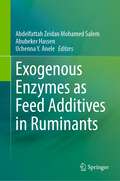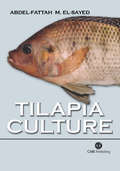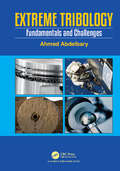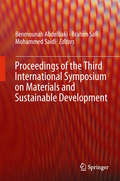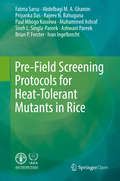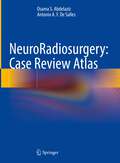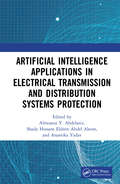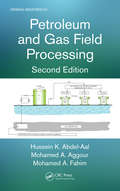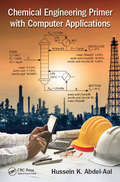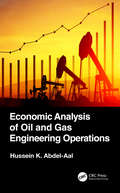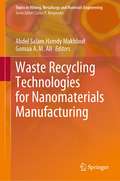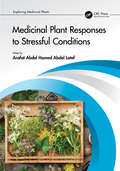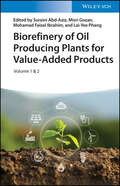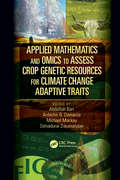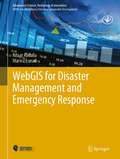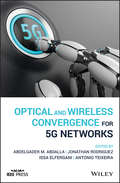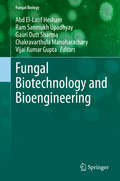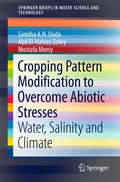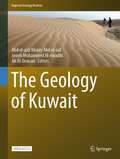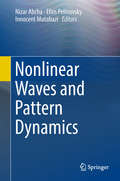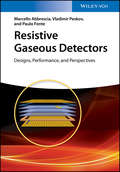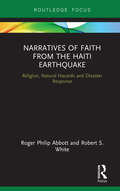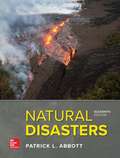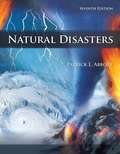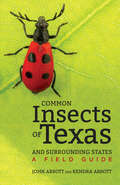- Table View
- List View
Exogenous Enzymes as Feed Additives in Ruminants
by Abdelfattah Zeidan Mohamed Salem Abubeker Hassen Uchenna Y. AneleThis book addresses a global issue of increasing high quality food from ruminant animals while reducing their impacts on the environment. However, one of the main constraints to livestock development and the underlying cause of the low productivity in many developing countries is inadequate nutrition associated with inefficient utilization of forages and fibrous feed resources. In many countries, fibrous feed makes up the bulk of available feed resource base, which is characterized by scarcity and fluctuating supply in the quantity and quality of feed resources, nutrient imbalance as seen in many native pastures, grasslands and crop residues-based feeding systems with limited use of commercial concentrate feeds such as soybean, cottonseed and groundnut meals, etc. Furthermore, the production of methane, an important greenhouse gas (GHG), from ruminants fed highly fibrous diets such as straws and stover is higher than those animals fed better quality forages or concentrate diets. Recent research shows that supplementing livestock diets with exogenous fibre degrading enzymes can improve feed utilization by enhancing intake, fibre degradation in the rumen and overall digestibility of fibrous feeds which in turn leads to improved animal performance, farmers’ income, and a reduction in GHG emissions. The book editors would like to acknowledge the Joint FAO/IAEA Division of Nuclear Techniques in Food and Agriculture for funding part of the studies that make up some of these chapters and were part of the final reports of a coordinated research project financed by IAEA.
Tilapia Culture
by Abdel-Fattah M. El-SayedTilapia culture is currently practiced in 95 countries all over the world and the number is expected to increase. This book discusses in detail the principles and practices of tilapia culture in the world. It covers all the vital issues of farmed tilapia including: the biology, environmental requirements, semi-intensive culture, intensive culture systems, feed and feeding, reproduction and breeding, spawning and larval rearing, stress and diseases, harvesting and marketing and the role of tilapia culture in rural development. It also highlights and presents the experiences of leading countries in tilapia culture.
Extreme Tribology: Fundamentals and Challenges
by Ahmed AbdelbaryTribology is an unfamiliar term for many, but is experienced by all. It is the science of friction, wear and lubrication of contacting surfaces in relative motion. The aim of this book is to introduce the fundamentals of tribology as well as its challenges in extreme operating conditions. The book comprises a historical background and an introduction to familiarize both undergraduate and postgraduate readers with such an important topic. It addresses a comprehensive coverage of classical tribology of solid contacts, friction mechanics, wear mechanisms and lubrication technologies. The tribology of polymer composites, MEMS and NEMS are explored. In addition, tribology of automotive components is presented, as are tribological applications in many practical situations.Various test methods used in evaluating wear are reviewed. Diverse techniques applied in predicting wear behavior by mathematical models, FE modeling and ANN approach are discussed. The book reviews key features of extraordinary conditions associated with, but not limited to, harsh environments, severe sliding and poor lubrication challenges. A basic understanding of failure modes in tribological systems is covered. The state-of-the-art research on tribology under these extreme conditions is extensively discussed, which will be of interest to researchers. The book highlights solutions for extreme tribology problems and provides an overview of various factors affecting tribosystems in harsh conditions.
Proceedings of the Third International Symposium on Materials and Sustainable Development
by Benmounah Abdelbaki Brahim Safi Mohammed SaidiThe third International Symposium on Materials and Sustainable Development ISMSD2017 (CIMDD2017) will include a 2-day Conferences (07 & 08 November). Organized by the Research Unit: Materials, Processes and Environment and University M'hamed Bougara of Boumerdes, this symposium follows the success of CIMDD 2013-2015 and continues the traditions of the highly successful series of International Conferences on the materials, processes and Environment. The Symposium will provide a unique topical forum to share the latest results of the materials and sustainable development research in Algeria and worldwide.
Pre-Field Screening Protocols for Heat-Tolerant Mutants in Rice
by Abdelbagi M.A. Ghanim Ivan Ingelbrecht Brian P. Forster Ashwani Pareek Sneh L. Singla-Pareek Muhammed Ashraf Paul Mbogo Kusolwa Rajeev N. Bahuguna Priyanka Das Fatma SarsuThis open access book presents simple, robust pre-field screening protocols that allow plant breeders to screen for enhanced tolerance to heat stress in rice. Two critical heat-sensitive stages in the lifecycle of the rice crop are targeted – the seedling and flowering stages – with screening based on simple phenotypic responses. The protocols are based on the use of a hydroponics system and/or pot experiments in a glasshouse in combination with a controlled growth chamber where the heat stress treatment is applied. The protocols are designed to be effective, simple, reproducible and user-friendly. The protocols will enable plant breeders to effectively reduce the number of plants from a few thousands to less than 100 candidate individual mutants or lines in a greenhouse/growth chamber, which can then be used for further testing and validation in the field conditions. The methods can also be used to classify rice genotypes according to their heat tolerance characteristics. Thus, different types of heat stress tolerance mechanisms can be identified, presenting opportunities for pyramiding different (mutant) sources of heat stress tolerance.
NeuroRadiosurgery: Case Review Atlas
by Osama S. Abdelaziz Antonio A.F. De SallesThis book is one-of-a-kind comprehensive Radiosurgery Case Review Atlas that includes not only cranial and spinal cases, but also structural and functional radiosurgery ones. It categorizes the various radiosurgery-treated pathologies, presenting illustrative case reviews for each category. Each case includes a clinical summary, a treatment protocol, a radiosurgery dosimetry summary, the pre-radiosurgery images and the serial, short-term and long-term, follow up images illustrating the clinical and radiologic outcomes of the radiosurgery treatment. Offering the readers a handy step-by-step practical guide to perform safe and effective radiosurgery treatment, this will be a useful toolkit for neurosurgeons, radiation neuro-oncologists and radiation physicists (Radiosurgeons) conducting radiosurgery programs or involved in radiosurgery training.
Artificial Intelligence Applications in Electrical Transmission and Distribution Systems Protection
by Almoataz Y. AbdelazizArtificial intelligence (AI) can successfully help in solving real-world problems in power transmission and distribution systems because AI-based schemes are fast, adaptive, and robust and are applicable without any knowledge of the system parameters. This book considers the application of AI methods for the protection of different types and topologies of transmission and distribution lines. It explains the latest pattern-recognition-based methods as applicable to detection, classification, and location of a fault in the transmission and distribution lines, and to manage smart power systems including all the pertinent aspects. FEATURES Provides essential insight on uses of different AI techniques for pattern recognition, classification, prediction, and estimation, exclusive to power system protection issues Presents an introduction to enhanced electricity system analysis using decision-making tools Covers AI applications in different protective relaying functions Discusses issues and challenges in the protection of transmission and distribution systems Includes a dedicated chapter on case studies and applications This book is aimed at graduate students, researchers, and professionals in electrical power system protection, stability, and smart grids.
Petroleum and Gas Field Processing (ISSN)
by Hussein K. Abdel-Aal Mohamed A. Aggour Mohamed A. FahimMany oil production processes present a significant challenge to the oil and gas field processing facilities and equipment design. The optimization of the sequential operations of handling the oil–gas mixture can be a major factor in increasing oil and gas production rates and reducing operating costs.Petroleum and Gas Field Processing provides an all-inclusive guide to surface petroleum operations and solves these and other problems encountered in the field processing of oil and gas. Fully revised and updated to reflect major changes over the past decade or so, this second edition builds on the success attained in the first edition. It delivers an expanded and updated treatment that covers the principles and procedures related to the processing of reservoir fluids for the separation, handling, treatment, and production of quality petroleum oil and gas products.With five new chapters, this second edition covers additional subjects, in particular natural gas, economics and profitability, oil field chemicals, and piping and pumps. The book also contains worked-out examples and case studies from a variety of oil field operations.
Chemical Engineering Primer with Computer Applications
by Hussein K. Abdel-AalTaking a highly pragmatic approach to presenting the principles and applications of chemical engineering, this companion text for students and working professionals offers an easily accessible guide to solving problems using computers. The primer covers the core concepts of chemical engineering, from conservation laws all the way up to chemical kinetics, without heavy stress on theory and is designed to accompany traditional larger core texts. The book presents the basic principles and techniques of chemical engineering processes and helps readers identify typical problems and how to solve them. Focus is on the use of systematic algorithms that employ numerical methods to solve different chemical engineering problems by describing and transforming the information. Problems are assigned for each chapter, ranging from simple to difficult, allowing readers to gradually build their skills and tackle a broad range of problems. MATLAB and Excel® are used to solve many examples and the more than 70 real examples throughout the book include computer or hand solutions, or in many cases both. The book also includes a variety of case studies to illustrate the concepts and a downloadable file containing fully worked solutions to the book’s problems on the publisher’s website. Introduces the reader to chemical engineering computation without the distractions caused by the contents found in many texts. Provides the principles underlying all of the major processes a chemical engineer may encounter as well as offers insight into their analysis, which is essential for design calculations. Shows how to solve chemical engineering problems using computers that require numerical methods using standard algorithms, such as MATLAB® and Excel®. Contains selective solved examples of many problems within the chemical process industry to demonstrate how to solve them using the techniques presented in the text. Includes a variety of case studies to illustrate the concepts and a downloadable file containing fully worked solutions to problems on the publisher’s website. Offers non-chemical engineers who are expected to work with chemical engineers on projects, scale-ups and process evaluations a solid understanding of basic concepts of chemical engineering analysis, design, and calculations.
Economic Analysis of Oil and Gas Engineering Operations
by Hussein K. Abdel-AalEngineers seek solutions to problems, and the economic viability of each potential solution is normally considered along with the technical merits. This is typically true for the petroleum sector, which includes the global processes of exploration, production, refining, and transportation. Decisions on an investment in any oil or gas field development are made on the basis of its value, which is judged by a combination of a number of economic indicators. Economic Analysis of Oil and Gas Engineering Operations focuses on economic treatment of petroleum engineering operations and serves as a helpful resource for making practical and profitable decisions in oil and gas field development. Reflects major changes over the past decade or so in the oil and gas industry Provides thorough coverage of the use of economic analysis techniques in decision-making in petroleum-related projects Features real-world cases and applications of economic analysis of various engineering problems encountered in petroleum operations Includes principles applicable to other engineering disciplines This work will be of value to practicing engineers and industry professionals, managers, and executives working in the petroleum industry who have the responsibility of planning and decision-making, as well as advanced students in petroleum and chemical engineering studying engineering economics, petroleum economics and policy, project evaluation, and plant design.
Waste Recycling Technologies for Nanomaterials Manufacturing (Topics in Mining, Metallurgy and Materials Engineering)
by Abdel Salam Hamdy Makhlouf Gomaa A. M. AliThis book discusses the recent advances in the wastes recycling technologies to provide low-cost and alternative ways for nanomaterials production. It shows how carbon nanomaterials can be synthesized from different waste sources such as banana fibers, argan (Argania spinosa) seed shells, corn grains, camellia oleifera shell, sugar cane bagasse, oil palm (empty fruit bunches and leaves) and palm kernel shells. Several nanostructured metal oxides (MnO2, Co3O4,….) can be synthesized via recycling of spent batteries. The recovered nanomaterials can be applied in many applications including: Energy (supercapacitors, solar cells, etc.) water treatments (heavy metal ions and dyes removal) and other applications. Spent battery and agriculture waste are rich precursors for metals and carbon, respectively. The book also explores the various recycling techniques, agriculture waste recycling, batteries recycling, and different applications of the recycled materials.
Medicinal Plant Responses to Stressful Conditions (Exploring Medicinal Plants)
by Abdel Latef, Arafat Abdel HamedMedicinal Plant Responses to Stressful Conditions discusses the effects of multiple biotic and abiotic stressors on medicinal plants. It features information on biochemical, molecular and physiological strategies used to mitigate or alleviate detrimental effects of biotic and abiotic stressors. The book contains chapters featuring medicinal plants of importance covering subjects including genomics, functional genomics, metabolomics, phenomics, proteomics and transcriptomics under biotic and abiotic stress of medicinal plants and their molecular responses. It suggests exogenous application of different types of stimulants to enhance medicinal plant production in such conditions. Features: Details all aspects of biotic and abiotic stressors in various important medicinal plant species. Chapters cover evidence-based approaches in the diagnosis and management of medicinal plants under stressful conditions. Includes information on ways to mitigate effects from biotic stress (diseases and pests) or abiotic stress (high salinity, drought, temperature extremes, waterlogging, wind, high light intensity, UV radiation, heavy metals and mineral deficiencies). A volume in the Exploring Medicinal Plants series, this book is an essential resource for plant scientists, botanists, environmental scientists and anyone with an interest in herbal medicine.
Biorefinery of Oil Producing Plants for Value-Added Products
by Suraini Abd-Aziz Misri Gozan Mohamad Faizal Ibrahim Lai-Yee PhangBiorefinery of Oil Producing Plants for Value-Added Products An instructive and up-to-date pretreatment and industrial applications of oil producing plants Biorefinery of Oil Producing Plants for Value-Added Products is a two-volume set that delivers a comprehensive exploration of oil producing plants, from their availability to their pretreatment, bioenergy generation, chemical generation, bioproduct generation, and economic impact. The distinguished team of editors has included a wide variety of highly instructive resources written by leading contributors to the field. This set explores the current and future potential of bioenergy production to address the energy and climate crisis, as well as the technologies used to produce materials like biogas, biodiesel, bioethanol, biobutanol, biochar, fuel pellets, and biohydrogen. It also discusses the production of biobased chemicals, including bio-oil, biosurfactants, catanionic surfactants, glycerol, biovanillin, bioplastic, and plant-oil based polyurethanes. Concluding with an insightful analysis of the economic effects of oil producing plants, the set also offers readers: A thorough introduction to the availability of oil producing plants, including palm oil, castor oil, jatropha, nyamplung, and coconut A comprehensive exploration of the pretreatment of oil producing plants, including the physical, chemical and biological pretreatment of lignocellulosic biomass Practical discussion of the generation of bioenergy, including biogas generation in the palm oil mill and biodiesel production techniques using jatropha In-depth examinations of the generation of biobased chemicals, including those produced from the tobacco plant Perfect for researchers and industry practitioners involved with the biorefinery of oil producing plants, Biorefinery of Oil Producing Plants for Value-Added Products also belongs in the libraries of undergraduate and graduate students studying agriculture, chemistry, engineering, and microbiology.
Applied Mathematics and Omics to Assess Crop Genetic Resources for Climate Change Adaptive Traits
by Abdallah Bari, Ardeshir B. Damania, Michael Mackay and Selvadurai DayanandanApplied Mathematics and Omics to Assess Crop Genetic Resources for Climate Change Adaptive Traits focuses on practical means and approaches to further the use of genetic resources for mitigating the effects of climate change and improving crop production. Genetic diversity in crop plants is being further explored to increase yield, disease resistance, and nutritional value by employing recent advances in mathematics and omics technologies to promote the adaptation of crops to changing climatic conditions. This book presents a broad view of biodiversity and genetic resources in agriculture and provides answers to some current problems. It also highlights ways to provide much-needed information to practitioners and innovators engaged in addressing the effects of global climate change on agriculture. The book is divided into sections that cover: The implications of climate change for drylands and farming communities The potential of genetic resources and biodiversity to adapt to and mitigate climate change effects Applications of mathematics and omics technologies Genomics and gene identification We are in the midst of significant changes in global climates, and its effects are already being felt throughout the world. The increasing frequency of droughts and heat waves has had negative impacts on agricultural production, especially in the drylands of the world. This book shares the collective knowledge of leading scientists and practitioners, giving readers a broader appreciation and heightened awareness of the stakes involved in improving and sustaining agricultural production systems in the face of climate change.
WebGIS for Disaster Management and Emergency Response (Advances in Science, Technology & Innovation)
by Rifaat Abdalla Marwa EsmailThis book aims to help students, researchers and policy makers understand the latest research and development trends in the application of WebGIS for Disaster Management and Emergency Response. It is designed as a useful tool to better assess the mechanisms for planning, response and mitigation of the impact of disaster scenarios at the local, regional or national levels. It contains details on how to use WebGIS to solve real-world problems associated with Disaster Management Scenarios for the long-term sustainability. The book broadens the reader understanding of the policy and decision-making issues related to Disaster Management response and planning.
Optical and Wireless Convergence for 5G Networks (Wiley - IEEE)
by Abdelgader M AbdallaThe mobile market has experienced unprecedented growth over the last few decades. Consumer trends have shifted towards mobile internet services supported by 3G and 4G networks worldwide. Inherent to existing networks are problems such as lack of spectrum, high energy consumption, and inter-cell interference. These limitations have led to the emergence of 5G technology. It is clear that any 5G system will integrate optical communications, which is already a mainstay of wide area networks. Using an optical core to route 5G data raises significant questions of how wireless and optical can coexist in synergy to provide smooth, end-to-end communication pathways. Optical and Wireless Convergence for 5G Networks explores new emerging technologies, concepts, and approaches for seamlessly integrating optical-wireless for 5G and beyond. Considering both fronthaul and backhaul perspectives, this timely book provides insights on managing an ecosystem of mixed and multiple access network communications focused on optical-wireless convergence. Topics include Fiber–Wireless (FiWi), Hybrid Fiber-Wireless (HFW), Visible Light Communication (VLC), 5G optical sensing technologies, approaches to real-time IoT applications, Tactile Internet, Fog Computing (FC), Network Functions Virtualization (NFV), Software-Defined Networking (SDN), and many others. This book aims to provide an inclusive survey of 5G optical-wireless requirements, architecture developments, and technological solutions.
Fungal Biotechnology and Bioengineering (Fungal Biology)
by Abd El-Latif Hesham Ram Sanmukh Upadhyay Gauri Dutt Sharma Chakravarthula Manoharachary Vijai Kumar GuptaFungi are eukaryotic microorganisms that include both unicellular and multicellular species. They have a worldwide distribution and a wide range of applications in diverse sectors, from environmental, food and medicine to biotechnological innovations. Fungal biochemical genetics involves the study of the relationships between genome, proteome and metabolome, and the underlying molecular processes in both native and bioengineered fungi. This book provides a valuable resource on the challenges and potential of fungal biotechnology and related bioengineering and functional diversity for various industrial applications in the food, environmental, bioenergy and biorefining, and the biopharma sectors. In comparison to previous and related publications in the area of applied myco-biotech-engineering, this book bridges a knowledge gap in the areas related to prospects and investment as well as intellectual and technical issues. This book also provides information on recent commercial and economic interests in the area by juxtaposing the developments achieved in recent worldwide research and its many challenges.
Cropping Pattern Modification to Overcome Abiotic Stresses: Water, Salinity and Climate (SpringerBriefs in Water Science and Technology)
by Abd El-Hafeez Zohry Samiha A. H. Ouda Mostafa MorsyThis book provides state-of-the art analysis, never done before in Egypt, on agro-climatic zones level. This study deals with how the national cropping pattern can be modified to overcome abiotic stresses, such as water scarcity, induced salinity and climate change to reduce their negative effects on food production. To this end, different cropping patterns are suggested. This study can be a framework for other developing countries to be used in quantifying and filling the gap in their knowledge about practices that can help in increasing their food security through increasing food production. Furthermore, the study is useful for policy makers to help them in their future plans and policies.
The Geology of Kuwait (Regional Geology Reviews)
by Abd el-aziz Khairy Abd el-aal Jasem Mohammed Al-Awadhi Ali Al-DousariThis open access book contains a set of chapters covering all aspects of geosciences related to Kuwait and adjacent regions, including Iran, Saudi Arabia and the Arab Gulf states. It covers basic information about the geology including a wide range of geoscientific disciplines such as marine geology, structural geology, hydrogeology and geophysics related to the region. This book is aimed at researchers and students, as well as professionals in the field of hazard mitigation and petroleum exploration.
Nonlinear Waves and Pattern Dynamics
by Nizar Abcha Efim Pelinovsky Innocent MutabaziThis book addresses the fascinating phenomena associated with nonlinear waves and spatio-temporal patterns. These appear almost everywhere in nature from sand bed forms to brain patterns, and yet their understanding still presents fundamental scientific challenges. The reader will learn here, in particular, about the current state-of-the art and new results in: Nonlinear water waves: resonance, solitons, focusing, Bose-Einstein condensation, as well as and their relevance for the sea environment (sea-wind interaction, sand bed forms, fiber clustering) Pattern formation in non-equilibrium media: soap films, chimera patterns in oscillating media, viscoelastic Couette-Taylor flow, flow in the wake behind a heated cylinder, other pattern formation. The editors and authors dedicate this book to the memory of Alexander Ezersky, Professor of Fluid Mechanics at the University of Caen Normandie (France) from September 2007 to July 2016. Before 2007, he had served as a Senior Scientist at the Institute of Applied Physics of the Russian Academy of Sciences in Nizhny Novgorod (Russia). The chapters have been written by leading scientists in Nonlinear Physics, and the topics chosen so as to cover all the fields to which Prof. Ezersky himself contributed, by means of experimental, theoretical and numerical approaches. The volume will appeal to advanced students and researchers studying nonlinear waves and pattern dynamics, as well as other scientists interested in their applications in various natural media.
Resistive Gaseous Detectors: Designs, Performance, and Perspectives
by Marcello Abbrescia Vladimir Peskov Paulo FonteThis first book to critically summarize the latest achievements and emerging applications within this interdisciplinary topic focuses on one of the most important types of detectors for elementary particles and photons: resistive plate chambers (RPCs). In the first part, the outstanding, international team of authors comprehensively describes and presents the features and design of single and double-layer RPCs before covering more advanced multi-layer RPCs. The second part then focuses on the application of RPCs in high energy physics, materials science, medicine and security. Throughout, the experienced authors adopt a didactic approach, with each subject presented in a simple way, increasing in complexity step by step.
Narratives of Faith from the Haiti Earthquake: Religion, Natural Hazards and Disaster Response (Routledge Focus on Religion)
by Roger Philip Abbott Robert S. WhiteThis book presents an in-depth ethnographic case study carried out in the years following the 2010 Haiti earthquake to present the role of faith beliefs in disaster response. The earthquake is one of the most destructive on record, and the aftermath, including a cholera epidemic and ongoing humanitarian aid, has continued for years following the catastrophe. Based on dozens of interviews, this book gives primacy to survivors’ narratives. It begins by laying out the Haitian context, before presenting an account of the earthquake from survivors’ perspectives. It then explores in detail how the earthquake affected the religious, mainly Christian, faith of survivors and how religious faith influenced how they responded to, and are recovering from, the experience. The account is also informed by geoscience and the accompanying "complicating factors." Finally, the Haitian experience highlights the significant role that religious faith can play alongside other learned coping strategies in disaster response and recovery globally. This book contributes an important case study to an emerging literature in which the influence of both religion and narrative is being recognised. It will be of interest to scholars of any discipline concerned with disaster response, including practical theology, anthropology, psychology, geography, Caribbean studies and earth science. It will also provide a resource for non-governmental organisations.
Natural Disasters
by Patrick Leon AbbottNatural Disasters, 11th edition focuses on explaining how the normal processes of Earth concentrate their energies and deal heavy blows to humans and their structures. Students have a natural curiosity about natural disasters and why they occur. This text explains why natural disasters occur by interweaving the themes of Energy sources, Plate tectonics, climate change, Earth Processes, geologic time, the complexities of multiple variables operating simultaneously throughout the text. Detailed and interesting Case histories are also intertwined with current content to give students a broad historical understanding of our dynamic and evolving planet.
Natural Disasters (7th edition)
by Patrick Leon AbbottNatural Disasters, 7th edition, focuses on how the normal processes of the Earth concentrate their energies and deal heavy blows to humans and their structures. It is concerned with how the natural world operates and, in so doing, kills and maims humans and destroys their works. Throughout the book, certain themes are maintained: energy sources underlying disasters plate tectonics and climate change; earth processes operating in rock, water, and atmosphere; significance of geologic time; complexities of multiple variables operating simultaneously; detailed and readable case studies.
Common Insects of Texas and Surrounding States: A Field Guide
by John C. Abbott Kendra AbbottA comprehensive field guide to Texas&’s insects, featuring 1,300 species and over 2,700 photographs. Thanks to its size and geographic position, Texas is home to nearly 30,000 species of insects, likely making its insect population the most diverse in the nation. Ranging from eastern and western to temperate and tropical species, this vast array of insects can be difficult to identify. In Common Insects of Texas and Surrounding States, John and Kendra Abbott have created the state&’s most comprehensive field guide to help readers recognize and understand these fascinating creatures. Containing 1,300 species and more than 2,700 photographs, this guide offers a wealth of information about the characteristics and behaviors of Texas&’s insects. Each chapter introduces an order with a discussion of general natural history and a description of other qualities helpful in distinguishing its various species, while every species&’ entry provides a state map showing where it is most likely to be found, a key displaying its seasonal distribution, information about its habitat, and corresponding photos. Featuring colored tabs for quick reference, a glossary, and information about other arthropods, this guide is the perfect companion for anyone wanting to identify and learn more about the many insects of Texas.&“Expertly written and beautifully illustrated, this exceptional book will be of interest to both professional and beginning naturalists.&” —Edward O. Wilson, University Research Professor Emeritus, Harvard University
